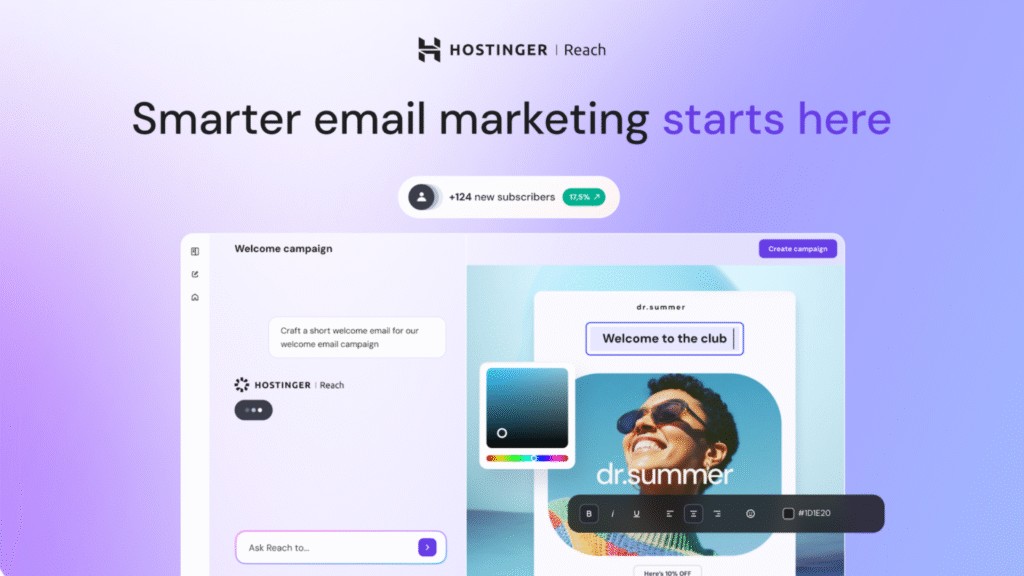Hostinger has recently made waves in the email marketing sphere with its new offering, Hostinger Reach. Unlike traditional email marketing platforms like Mailchimp and Omnisend, Hostinger Reach is designed for users without technical skills. This tool simplifies the email creation process, allowing businesses to generate professional emails within minutes by simply inputting a prompt. The built-in AI features enable users to tap into automated designs and wording, saving both time and effort typically required for crafting effective marketing emails.
In terms of deliverability, Hostinger Reach comes with pre-configured deliverability tools—SPF, DKIM, and DMARC—automatically set up with Hostinger domains. These features aim to improve email inbox landing rates. However, it’s crucial to acknowledge that email deliverability can be influenced by multiple factors, not solely dependent on the configuration of DNS records. By including functionalities like contact management, campaign analytics, and compliance with GDPR and CAN-SPAM regulations, Hostinger Reach offers a robust solution for small to medium-sized businesses.
On the other hand, Mailchimp remains a premier choice in the email marketing landscape. Known for its user-friendly interface and extensive integration capabilities, Mailchimp caters to businesses of all sizes. Its features include advanced segmentation, A/B testing, and comprehensive analytics, enabling marketers to refine their strategies based on real-time data. For SMBs looking to establish a more targeted approach, Mailchimp’s diverse integrations with platforms like Shopify and WordPress can provide enhanced customization possibilities. This flexibility can often result in more tailored marketing campaigns, helping to improve customer engagement.
Pricing is another critical factor to consider. Hostinger Reach offers a free tier, allowing up to 200 monthly emails to 100 unique subscribers, making it an attractive entry-level option for small businesses. Paid plans will expand capabilities, although pricing details are currently unclear. In contrast, Mailchimp has a freemium model that includes more robust features from the outset, which may justify higher costs for businesses looking to scale quickly. Its pricing structure considers the number of subscribers and email sends, which can become more cost-effective as the business grows.
When it comes to integrations, Mailchimp clearly outperforms Hostinger Reach. While Hostinger Reach smoothly syncs with its own Website Builder, it currently lacks deep third-party integrations. For many small businesses that heavily utilize WordPress or Shopify, this limitation could hinder the seamless experience they might be seeking. Mailchimp, with its extensive ecosystem, enables SMBs to connect their email campaigns directly to sales platforms, enhancing tracking and performance analytics.
Support is another area where Mailchimp shines. It offers 24/7 customer service through various channels, including live chat and email, making it a reliable option for businesses seeking prompt assistance. Hostinger Reach’s support details are less transparent, potentially leaving users in a lurch if they encounter issues. Having responsive support can be pivotal during campaigns, especially if timing is critical.
For SMBs, deciding between Hostinger Reach and Mailchimp largely depends on individual business needs. For instance, businesses that prioritize limited budgets and simplified operations might find Hostinger Reach appealing, particularly in the exploratory phase of email marketing. However, if a business requires advanced features, detailed analytics, and extensive integrations, Mailchimp may be the better choice, despite its higher price point.
Migrating to either platform is relatively straightforward. For businesses choosing to move to Hostinger Reach, the setup could involve syncing existing email lists and importing them into the new system using CSV files. A low-risk pilot could involve running a small campaign using the free tier to gauge performance without financial commitment. For businesses shifting to Mailchimp, a similar approach can be taken, utilizing their migration tools to automate the process.
In terms of total cost of ownership, businesses should consider not only the subscription fees but also the time spent setting up campaigns and potential costs from integrating third-party tools. Hostinger Reach may appear less expensive initially, but as the business scales, hidden costs could arise if the tool does not meet growing demands. In contrast, while Mailchimp’s initial costs may seem higher, its comprehensive capabilities can yield substantial ROI over three to six months. The ability to engage more effectively with customers can lead to better customer retention and increased sales, ultimately paying for itself.
FlowMind AI Insight: In a rapidly evolving landscape, choosing the right email marketing software involves careful consideration of features, pricing, integrations, and support. While Hostinger Reach is ideal for those just starting their email marketing journey, Mailchimp presents a comprehensive solution for businesses ready to elevate their marketing efforts. Understanding your unique needs and conducting a pilot test can significantly minimize risks and enhance your operational efficiency.
Original article: Read here
2025-06-15 07:00:00

